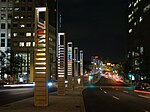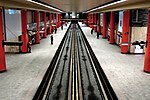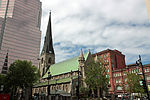KPMG Tower

The KPMG Tower, formerly Maison des Coopérants or Place de la Cathédrale, is a 34-storey skyscraper in downtown Montreal, Canada, that was completed in 1987. It is at 600 de Maisonneuve Ouest and has an official height of 146 m (479 ft). The building is owned and operated by BentallGreenOak. The KPMG Tower was built on a plot of land owned by the Christ Church Cathedral, which lies directly in front of the building when viewed from Saint Catherine Street. It was designed by WZMH Architects and was styled to relate to the cathedral. The tower incorporates an underground shopping centre, Promenades Cathédrale, as part of the underground city that is connected to the Metro.
Excerpt from the Wikipedia article KPMG Tower (License: CC BY-SA 3.0, Authors, Images).KPMG Tower
Boulevard De Maisonneuve Ouest, Montreal Ville-Marie
Geographical coordinates (GPS) Address External links Nearby Places Show on map
Geographical coordinates (GPS)
| Latitude | Longitude |
|---|---|
| N 45.5041 ° | E -73.5708 ° |
Address
Tour KPMG
Boulevard De Maisonneuve Ouest 600
H3A 3J2 Montreal, Ville-Marie
Quebec, Canada
Open on Google Maps









